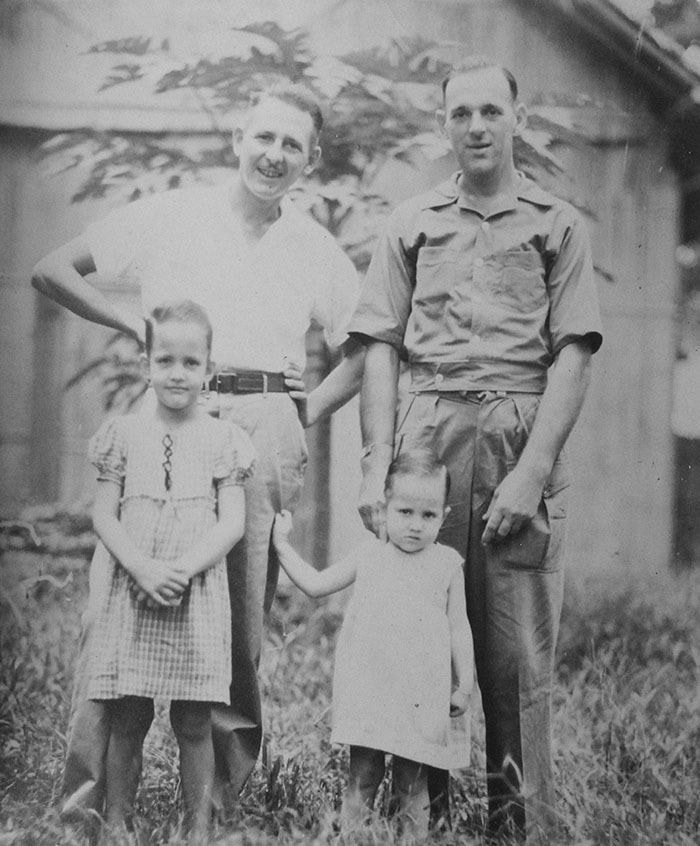Catherine Gilbert
Special to the Mirror
Saturday, Aug. 15 marked 70 years since Japan surrendered to the Allies, effectively ending the war in the Pacific.
It may have been the end of a conflict, but it left a lasting effect on many who survived the tumultuous era of Japanese domination in southeast Asia. One such survivor is Beja Koeleman, a resident of Campbell River, who for many years lived with dark and obscure memories of her early childhood spent in a Japanese camp in Indonesia, until her husband Pieter Koeleman decided to bring to light the story of her family’s confinement.
Pieter was aware that for many years Beja suffered from nightmares. She would wake up terrified, with a vision of a sandy beach and an airplane on fire up above.
He knew that his wife was born in Indonesia in the years it was under Dutch rule, and had spent her early years interred in a Japanese camp, but he knew little else. The few memories she had were vague, and Beja said that while her father was alive he was reluctant to talk to her about the war. But every March, the time of year when the confinement began, she would think about the past and wonder about uncovering her buried memories.
Finally in 2008, Pieter decided it was time to find out what had actually happened in Indonesia during World War II, and how his wife’s experiences fit into the larger story.
All Pieter and Beja knew to begin with was that Beja was just two years old when the Japanese invaded Indonesia in early 1942. Her father, Leendeert van Duijn, was called to military service with the Royal Dutch Indies Army and was away when her mother Thea, herself, her month old baby sister Helene and paternal grandmother Elisabeth Lucht-Kuiters were grouped together with other women and children, forced to leave their home and interred in a Japanese camp. They found out later that the father had already been confined to a camp for men. He wasn’t even aware that he had a second daughter.
Pieter began his search by placing an ad in a Dutch newspaper de Krant asking for anyone who might remember the van Duijn family. He received a surprising response. A lady in Arizona by the name of Ina Leidelmejer wrote to Pieter and Beja saying that she not only knew the family, but that she was actually interred in the same camp with Beja, her sister, mother and grandmother.
Ina was able to enlighten the Koelemans with many facts about the place where the van Duijn family had lived in the colony the Giesting (South Sumatra) and that she knew the family when they resided there. Their contact with Ina proved to be invaluable and she became a family friend, and continued to correspond with them up until her death in 2012.
In all, Pieter corresponded with seven different people. Another Dutch Indonesian from California supplied Pieter with further clues. He was sent excerpts from a book entitled Geillustreerde Atlas van de Japanese Kampen in Nederlands-Indië 1942-1945 (An Illustrated Atlas of Japanese Camps in Dutch Indonesia, 1942-1945).
Pieter eventually spoke to the editor of the book who was able to track down a copy of the book for him, which turned out to be in two volumes. The Atlas, which contains numerous revealing photos of camp prisoners, illustrates the appalling state of people’s health and how poor camp conditions were. Pieter also read an account of camp life by Helen Colijn.
A representative of the Dutch War Documentation Centre provided the additional information that the family was moved eight times to different camps during a three and a half year time period, something the Koelemans had been unaware of. The result of Pieter’s research is a booklet he wrote about the van Duijn family history and their experiences in Dutch Indonesia.
It isn’t surpising that Beja’s memories of the war years would be obscure. Both her mother and grandmother passed away while they were confined, and one of Beja’s few clear memories is of the day her mother died. A nun took Beja – who by this time was about five years old – and her sister to visit their mother who had been placed in a sick hut. In her hand, Beja had a small biscuit which she gave to her mother, who was laying inert on a cot.
The next day she found out that her mother had passed away, and thought that it was because of the food. Finding Beja in distress, a kindly nun took her to look at the night sky and pointing at the stars said, “Look at that bright star Beja, that is your mother.”
Although the Japanese surrendered in August, it took about two months before people were released from the camps. The two girls were taken to the city of Palembang, where they were cared for by nuns with the other motherless children.
It wasn’t until the spring of 1946 that their father finally found them. He hardly knew Beja, who was four years older than when he had last seen her, and he didn’t know his other daughter at all, who had to introduce herself saying, “I am Helene Harriete van Duijn.”
As a result of Pieter’s efforts, a dark period in his wife’s past came to light, and Beja realized that as they uncovered her story, her nightmares went away.
After her father found them, Beja and her sister went with him to Holland; a new and strange country for her as she had never been there before.
In 1960, she met Pieter Koeleman and in 1963 they married. Pieter trained as a physiotherapist and they had four children, then after visiting Pieter’s two brothers in British Columbia, decided to emigrate to Canada in 1985, and have lived in Campbell River ever since.
